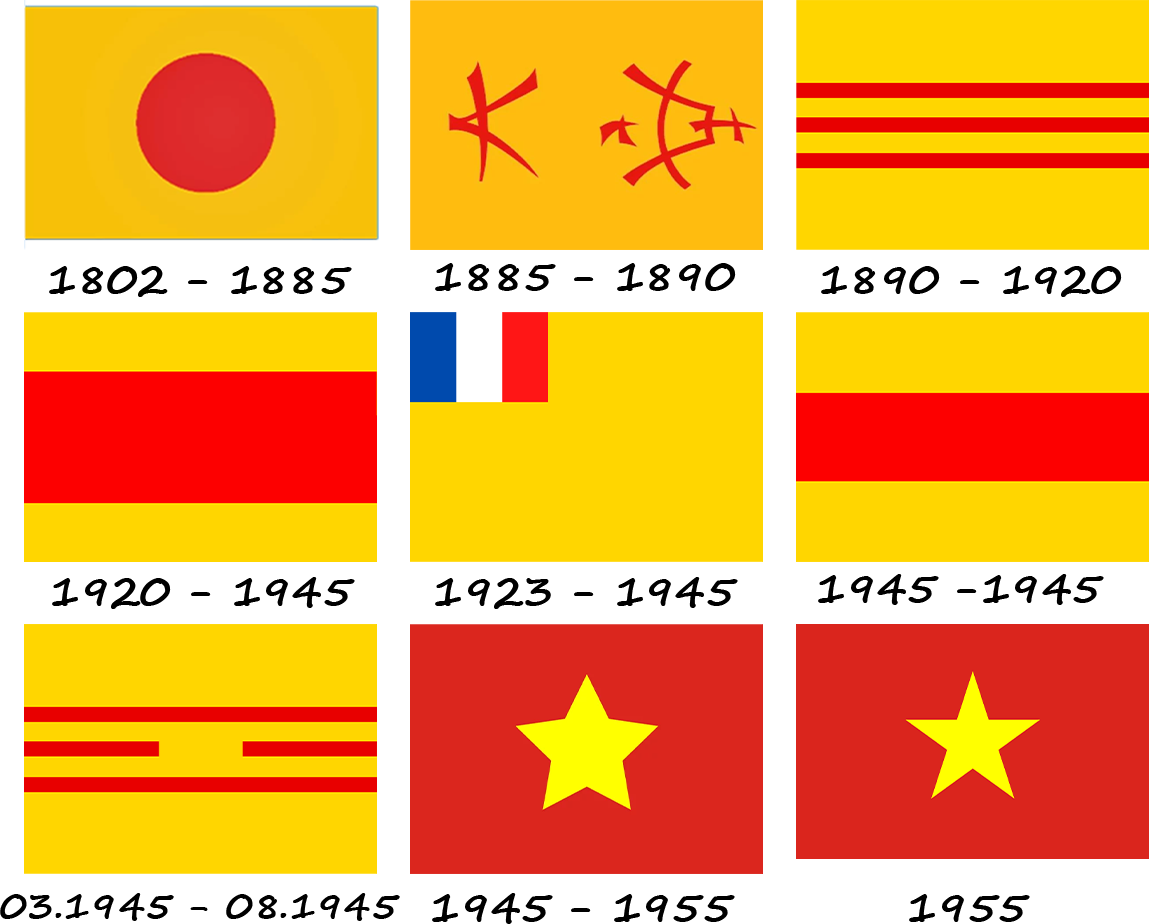The red flag with a yellow star is rectangular in shape, 2/3 of the length is wide, the background is red, and there is a five-pointed yellow star in the middle.
The red flag with a yellow star is rectangular in shape, 2/3 of the length is wide, the background is red, and there is a five-pointed yellow star in the middle.
Compared to the 1945 National Flag, the 1956 National Flag with a red background and yellow star has minor changes: the star's edges are now straight instead of curved as before. However, the soul of the flag and its meaning have not changed, and it has become a beautiful, impressive symbol imbued with the Vietnamese nation.
1802 - 1885. The name of the flag is Long Tinh Kỳ. "Long" symbolizes a dragon, so it is depicted in yellow, "Tinh" - "Shadow", a star in the sky in red - symbolizes the enthusiasm of the South.
1885 - 1890. The national flag of the country, used from 1885 to 1890.

1890 - 1920. The national flag with a yellow background and three red stripes was the flag of the two French resistance dynasties from 1890 to 1920. The national flag is also known as the "yellow flag" and is considered the first flag to correctly represent the country of Vietnam with independent and united aspirations. Three identical red stripes symbolize three inseparable regions: North, Center, and South.
1920 - 1945. The flag of North Central Vietnam during the period when the South became a French colony. The flag has a yellow background and a large horizontal red stripe. It is a unique symbolic flag of North and Central Vietnam. This flag is derived from the flag used between 1802 and 1885, except that the red dot was extended to a line.
1923 - 1945. This flag was also used when the South was a French colony. The flag has a yellow background with the blue-white-red flag of France in the left corner. On March 10, 1945, Japan overthrew the French in Indochina, and this was the last day it was used.
1945 - 1945. The flag was in use during the Japanese occupation of Indochina from March 1945 to August 1945. The flag has a yellow background and a horizontal red stripe in the middle, which occupies 1/3 of the area.
1945 - 1945. The flag of the Vietnamese nation during the Japanese occupation of Indochina from March 1945 to August 1945. The flag has a yellow background, three red stripes, and a torn red stripe in the middle. Since the country was under the rule of the monarchy during this period, Bao Dai cautiously decreed that he would accept the proposal of Prime Minister Chiang Chong Kim, take a new national name, and create a new national flag.
1945 - 1955. It is called the flag of the Vietminh Front of the Provisional Revolutionary Government of the "Democratic Republic of Vietnam". The flag appeared from May 1945 to December 1946. The flag has a red background and a yellow star, but the wings are slightly bent and have a more rounded star shape. On September 5, 1945, Ho Chi Minh signed a decree and decided to adopt the Vietminh flag as the national flag of Vietnam. However, in 1946, when the French army became increasingly stronger and gained many advantages, forcing the Viet Minh army to withdraw from resistance, the red flag of Vietnam temporarily lost its status and the country was divided into two regions: North and South.
1955. The final flag of the modern look is a five-pointed star on a red background.
During the uprising in Cochinchina against the French colonizers in late 1940, a red flag with a yellow star first appeared, which flew in many localities and later became the flag of Vietnam. The author of the first such flag was Nguyen Huu Tien.
In May 1941, the Vietnam Front was established. The Vietnam program clearly stated: "After the expulsion of the French and Japanese imperialists, we will establish the People's Government of the Democratic Republic of Vietnam, taking the throne with the red flag." A 5-rayed yellow star as the national flag. This is the first document to mention the national flag of Vietnam.
In mid-August 1945, the National Congress met in Tan Trao (Tuyen Quang Province) and decided to use the Viet Minh flag (a 5-rayed yellow star on a red background) as the flag of the uprising to seize power throughout the country.
The August Revolution of 1945 was successful, and the first National Assembly of the Democratic Republic of Vietnam in 1946 enshrined this in the Constitution: "The national flag of the Democratic Republic of Vietnam is rectangular on a red background, two-thirds of the length is wide, and there is a five-pointed yellow star in the middle.
In 1976, after the reunification of Vietnam, the Sixth National Assembly of Vietnam adopted a red flag with a yellow star as the national flag of the Socialist Republic of Vietnam, with minor changes.